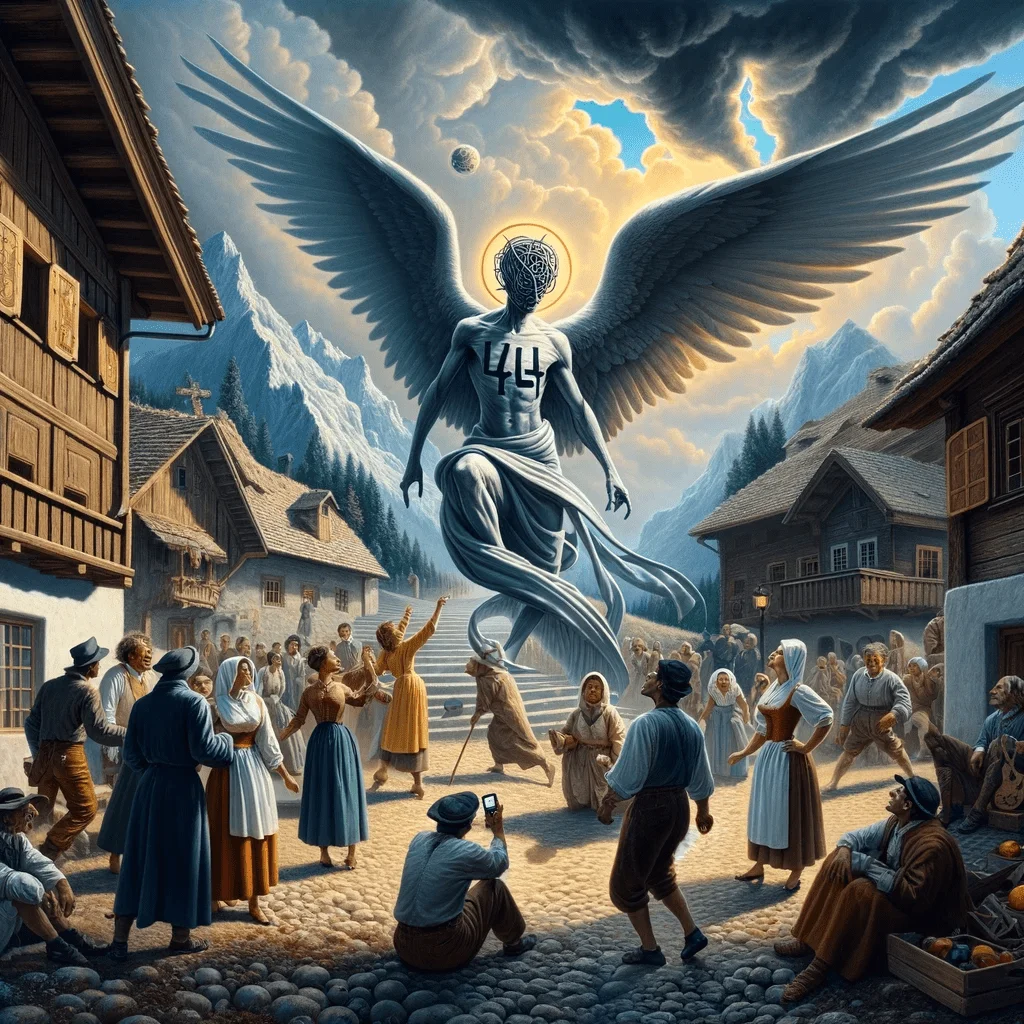The Mysterious Stranger

“The Mysterious Stranger” is a novella by Mark Twain, featuring the supernatural character of Satan’s nephew, also known as “Number 44.” Set in a remote Austrian village, the story explores themes of human morality, the nature of evil, and the role of the supernatural in people’s lives. The posthumously published version of the novella, assembled by Twain’s literary executor Albert Bigelow Paine, is the most widely read version today.
- In “The Mysterious Stranger,” Twain questions the nature of reality and the human perception of it. Number 44 introduces the concept of “dreams” and the idea that life itself might be a dream, an illusion created by the mind. This idea challenges the reader’s understanding of existence and invites them to reflect on the significance of their own experiences.
- The novella emphasizes the power of the human mind and its ability to shape one’s reality. Number 44 demonstrates this by manipulating the villagers’ thoughts, feelings, and actions through his supernatural abilities. This theme suggests that individuals have more control over their lives than they might realize, and that the power of their thoughts can be transformative.
- Twain explores the dual nature of human beings – the capacity for both good and evil – through the character of Number 44. While he possesses immense power, he also displays a deep understanding of humanity and its complexities. The story suggests that people have the potential to choose between good and evil, but are often influenced by external factors, such as societal norms or personal circumstances.
- The novella examines the role of religion in people’s lives and the impact of religious beliefs on their actions. The villagers in the story are devout Christians, but their faith is challenged when they encounter Number 44 and his otherworldly powers. Twain questions the authority of religious institutions and the rigidity of their doctrines, implying that a more open-minded and flexible approach to spirituality might be more beneficial.
- “The Mysterious Stranger” highlights the limitations of human understanding, especially when faced with the inexplicable. The villagers are unable to comprehend the true nature of Number 44 and his abilities, leading them to fear and mistrust him. This theme underscores the importance of humility and curiosity in the pursuit of knowledge, as well as the need to accept the limits of human understanding.
Important Characters:
- Number 44: Also known as Satan’s nephew, he is the central character of the story. His supernatural powers and mysterious origins make him an enigmatic figure that challenges the villagers’ beliefs and understanding of reality.
- Theodor Fischer: The young protagonist of the story, Theodor is an apprentice in a print shop and becomes close friends with Number 44. He is a curious and open-minded character who serves as the reader’s guide through the narrative.
- Heinrich Stein: The master printer and owner of the print shop, Heinrich is an influential figure in the village. His encounters with Number 44 lead to personal growth and a changed perspective on life and reality.
- Nikolaus Balthasar: Another apprentice at the print shop, Nikolaus is a more skeptical character who finds it difficult to accept Number 44’s supernatural powers and the ideas he presents.
Books about “The Mysterious Stranger”:
- “Mark Twain’s Mysterious Stranger: A Study of the Manuscript Texts” by William M. Gibson: This book provides a detailed examination of the three different manuscripts of “The Mysterious Stranger” and the textual differences between them. Gibson offers insight into Twain’s creative process and the evolution of the story over time, as well as exploring the major themes and characters in each version.
- “The Eseldorf Manuscript: Mark Twain’s The Mysterious Stranger” by John S. Tuckey: Focusing on the Eseldorf manuscript, Tuckey looks into the literary and historical context of Twain’s novella, offering a comprehensive analysis of the themes, style, and symbolism in the work. The book also discusses the influence of Twain’s personal experiences and beliefs on the development of “The Mysterious Stranger.”
- “Number 44 and the Socio-Political Landscape: An Analysis of Mark Twain’s The Mysterious Stranger” by Laura E. Skandera-Trombley: Skandera-Trombley’s book explores the socio-political implications of “The Mysterious Stranger,” examining how Twain’s novella reflects and critiques the social, political, and religious issues of his time. The author also investigates the connections between Twain’s personal experiences and the themes in the story, shedding light on the author’s intentions and motivations.
- The Aesthetics of Race, Class, and Gender in The Mysterious Stranger” by Susan K. Harris: Harris’s book focuses on the ethical dimensions of “The Mysterious Stranger,” analyzing how Twain’s novella engages with issues of race, class, and gender. The author argues that Twain’s exploration of these topics in the story is an example of his commitment to ethical realism, a literary approach that seeks to represent the complexities of human experience in a morally responsible manner.
“The Mysterious Stranger” by Mark Twain is a thought-provoking novella that examines the nature of reality, the power of the human mind, the duality of human nature, the role of religion, and the limitations of human knowledge. The story features several important characters, including Number 44, Theodor Fischer, Heinrich Stein, and Nikolaus Balthasar. A number of books have been written about “The Mysterious Stranger,” offering in-depth analyses of the various manuscripts, themes, and socio-political context of the work.

